Wild seaweed harvesting: strategic environmental assessment - environmental report
Investigates the sustainability and potential environmental impacts of wild seaweed and seagrass harvesting, maerl extraction and removal of beach-cast seaweed.
3. Wild Seaweed and Seagrass Harvesting
3.1. Seaweed and Seagrass
3.1.1. The term seaweed is the collective name for a number of different groups of macroscopic, multicellular, marine algae (macroalgae). Seaweeds in Scotland's coastal waters fall into the following five broad categories:
- Wracks (rockweeds): large brown seaweeds of the taxonomic order Fucales. Species include Ascophyllum nodosum (Egg wrack) [4] , Pelvetia canaliculata, Fucus vesiculosus, F. spiralis, F. serratus and Himanthalia elongata.
- Kelps: large brown seaweeds of the taxonomic order Laminariales. Scotland's kelp forests mainly comprise Laminaria hyperborea, but also include Laminaria digitata, Alaria esculenta, Saccharina latissima (formerly Laminaria saccharina) and Saccorhiza polyschides.
- Green seaweeds: smaller, simpler in structure and shorter-lived than wracks and kelps; generally, range from a few centimetres to a metre in length. Key species in Scotland include Ulva intestinalis and U. lactuca.
- Red seaweeds: smaller than wracks and kelps with a similar size range to the green seaweeds. In Scotland, this group includes perennial species ( e.g. Chondrus crispus, Mastocarpus stellatus and Palmaria palmata) and annual species ( e.g. Porphyra umbilicalis).
- Calcified seaweeds (namely maerl): a calcium-carbonate encrusted red alga which produces calcareous prolongations. These accumulate subtidally as dense beds of calcareous material, both living and dead. The two species of maerl found in Scotland are Lithothamnion glaciale and Phymatolithon calcareum.
3.1.2. Examples of seaweed species in Scotland are provided in Figure 1.
3.1.3. Seagrasses are grass-like flowering plants with dark green, long, narrow, ribbon-shaped leaves. They are unique in being the only truly marine flowering plants or angiosperms (Heminga and Duarte, 2008). Seagrass species in Scotland comprise Zostera marina [5] , Z. noltii, and Ruppia maritima [6] . The closely related and morphologically very similar R. cirrhosa is not widespread in Scotland.
Figure 1: Examples of seaweed
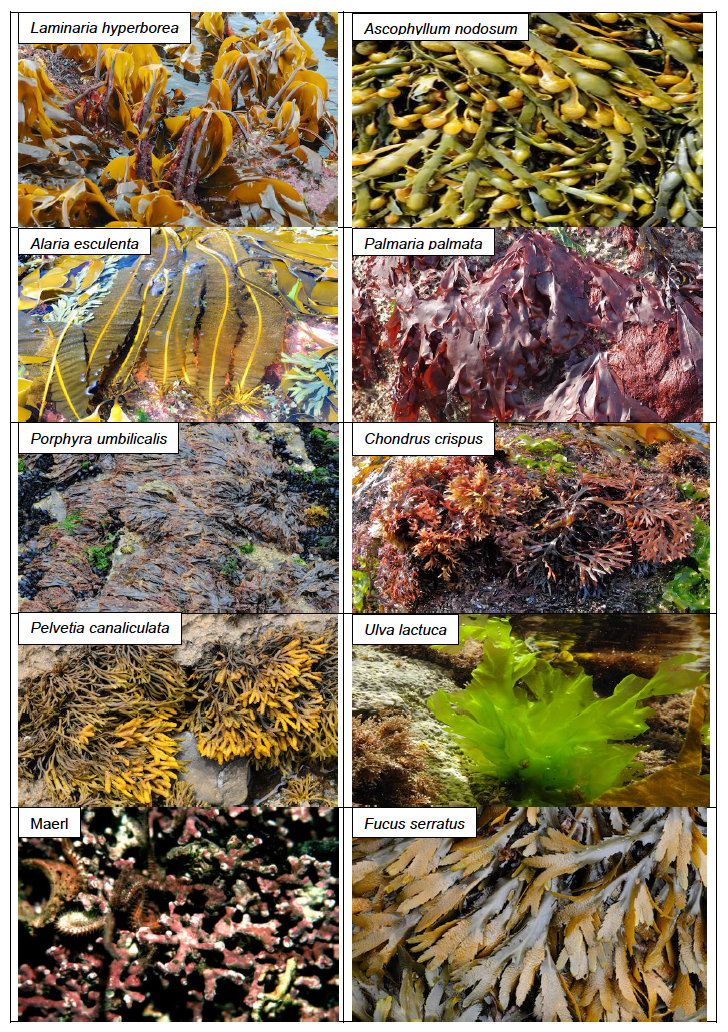
3.2. Location of the Seaweed and Seagrass Resource
3.2.1. The known (recorded) and potential distribution of each of the broad groups of seaweeds and seagrasses in Scottish waters has been mapped ( Figure 2 and Figure 3 [7] ). Information on the mapping process is provided in Appendix A .
3.2.2. An overview of the distribution of each broad group and key corresponding EUNIS habitats is provided in Table 3. Further information on the specific EUNIS habitats that represent each of the broad seaweed and seagrass groups in the distribution maps and the spatial data layers used is included in Appendix C (Table C2) .
Figure 2: Available spatial information on the distribution of kelps, maerl, wracks and green seaweeds

Figure 3: Available spatial information on the distribution of potential areas for kelps, and the distribution of red seaweeds, seagrasses and beach-cast seaweeds or seagrasses
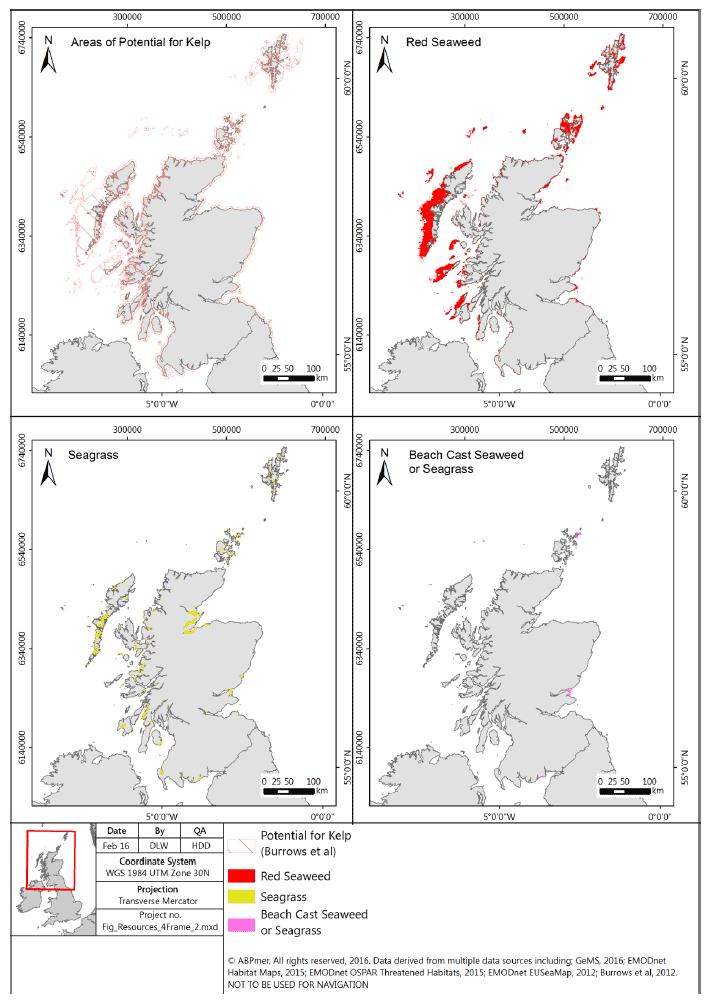
3.2.3. Spatial coverage is also provided in Table 3. The table includes an estimate for each of the broad groups of living seaweeds and seagrasses and beach-cast seaweeds and seagrasses in Scottish waters, based on available data. These area estimates do not account for the quality of the resource (in terms of biomass and density) and whether it is suitable for harvesting. Furthermore, there is a large area of Scotland's foreshore and intertidal zone with no data available but which may also provide additional biological resource.
Table 3: Summary of distribution and potential coverage of each of the broad groups of seaweed and seagrass in Scotland
| Broad group |
Key EUNIS Habitat Codes (Level 3) |
Approximate Area (km 2) |
Distribution |
|---|---|---|---|
| Wracks |
A1.15 Fucoids in tide-swept conditions A1.21 Barnacles and fucoids on moderately exposed shores A1.31 Fucoids on sheltered marine shores A1.32 Fucoids in variable salinity A3.22 Kelp and seaweed communities in tide-swept sheltered conditions A3.34 Submerged fucoids, green or red seaweeds (low salinity infralittoral rock) |
62 |
Wracks primarily grow on intertidal rocky shores and also on sheltered, mud, sand or gravel shores. They are recorded along much of the coast of Scotland but appear to be most abundant in Western Scotland, the Inner and Outer Hebrides, Orkney and Shetland (Figure 2). Smaller areas of wracks are also located along the southeast coast of Scotland. In terms of biomass, the majority of Ascophyllum nodosum around the Outer Hebrides is primarily located around Lewis, North Uist and South Uist and Harris (Burrows et al., 2010). |
| Kelps |
A3.32 Kelp in variable or reduced salinity A5.52 Kelp and seaweed communities on sublittoral sediment |
10,004 (15,042) |
Kelps are mainly found on suitable rocky areas all around the Scottish coastline, most extensively around Skye and the west coast mainland, as well as along the coast of the Inner and Outer Hebrides ( e.g. Norton & Powell, 1979; Brodie & Wilbraham, 2012) and around Orkney and Shetland (Figure 2, Lancaster et al., 2011; Wilkinson, 1995). There are fewer records of kelps on the east coast of Scotland, where much of the seabed is composed of sand ( SNH, undated), although some significant patches of kelps do occur, particularly along the northeast and southeast Scottish coast. |
| Green seaweeds |
A3.34 Submerged fucoids, green or red seaweeds (low salinity infralittoral rock) |
3 |
The majority of green seaweeds that have been digitally mapped are in the Outer Hebrides, in patches along the Western coast of the mainland, and also in Shetland and Orkney (Figure 2). The distribution of this group is likely to have been highly underestimated as it is a less conspicuous intertidal species that does not regularly form a dominant feature/biotope in the available spatial data layers. For example, there is known to be an abundance of Ulva sp. in some estuaries ( e.g. in Ythan and Montrose Basin) which has not been captured in the available spatial data layers (Raffaelli et al., 1989; JNCC, 1995). |
| Red seaweeds |
A3.11 Kelp with cushion fauna and/or foliose red seaweeds A3.21 Kelp and red seaweeds (moderate energy infralittoral rock) A3.33 Mediterranean submerged fucoids, green or red seaweeds on full salinity infralittoral rock A3.34 Submerged fucoids, green or red seaweeds (low salinity infralittoral rock) |
8,695 |
The majority of red seaweeds are located along the west coast of Scotland, the Inner Hebrides, the west coast of the Outer Hebrides and around Orkney and Shetland. Some smaller patches of red seaweeds are also found on the north and east coasts of Scotland (Figure 3). |
| Maerl |
A5.51 Maerl beds |
42 |
Maerl is usually restricted to places such as the sills of fjords and fjards (sea lochs in Scotland), together with the shores to the leeward of headlands and island archipelagos (Lancaster et al., 2014a). Maerl is found along the west coast of Scotland, in the Western Isles, Orkney, Shetland and the north coast, but is absent from the east coast (Figure 2). In the west region maerl is found within sea lochs and inlets on the mainland such as the Sound of Arisaig and Loch Laxford and areas such as Loch nam Madadh and the Sound of Barra in the Outer Hebrides. In the north region, there are widespread records of maerl beds in tide-swept areas, especially in Orkney and Shetland and Loch Eriboll on the north coast of the Scottish mainland. |
| Seagrasses |
A2.61 Seagrass beds on littoral sediments A5.53 Sublittoral seagrass beds |
112 |
The largest seagrass beds are found in Cromarty Firth, Moray Firth and Dornoch Firth (Figure 3). Other seagrass beds found in Scotland are typically small. There are some beds in the Outer Hebrides, including Loch Maddy and Loch Bi, and in Islay. Other smaller beds are found along the West coast of Scotland, such as in Loch Ryan, Loch Sunart, in the Montrose Basin and in the Forth and Tay Estuaries ( JNCC, 1995; SNH, undated). |
| Beach-cast seaweeds/ seagrasses |
A2.21 Strandline |
<1 |
There is very limited information on the distribution of strandline habitat which might include beach-cast seaweeds/seagrasses from the available spatial data layers (Figure 3). The only strandline habitat that has been recorded is in outer Tay Estuary and north coast of Orkney. However, it is considered likely that this habitat will occur wherever there is a beach located close to kelp habitat for example along the beaches on the southwest coast of the Outer Hebrides, parts of the Inner Hebrides ( e.g. Tiree), in Orkney and Shetland and the west coast of the Scottish mainland. |
Approximate area covered by potential for kelps (Burrows et al., 2014) is provided in the table in brackets.
3.3.1. Many environmental factors affect the distribution of seaweed and seagrasses. These can be abiotic (physical or chemical features) or biotic factors, such as biological competition. The major abiotic factors influencing seaweed and seagrass growth are light, temperature, salinity, water motion, wave exposure, nutrient availability and exposure to air (desiccation) (Lobban & Harrison, 1994; Smale et al., 2016). Living seaweeds and seagrasses are present in the intertidal zone and in subtidal coastal areas where sunlight reaches the seabed ( i.e. the infralittoral zone). Beach-cast seaweeds (mainly kelps) and (potentially) seagrasses may occur on the shoreline in drift lines, as a result of wave action during storms.
3.4. Seaweeds
3.4.1. Each seaweed species' tolerance of environmental conditions determines where it will occur and it abundance within its distribution range. Two abiotic factors are key in determining distributions on rocky shores; the vertical position on the shore in relation to the tides and the degree of wave action.
3.4.2. Positions higher up the shore in the intertidal or littoral zone are more stressful because the organisms, which are marine, have to withstand increased periods out of seawater, exposed to the drying effect of air, and the salinity shock of fresh rainwater. Below the low water mark, increasing depth results in a very rapid decrease in light intensity so that sublittoral (subtidal) species are restricted to a depth range near the surface, known as the photic zone, where light is sufficient for growth. Within the photic zone species may also be zoned based on their light requirements or their tolerance to damaging wave action around the low water mark.
3.4.3. The effects of wave action occur in both the littoral and sublittoral zones of rocky shores: in general, species can be recognised as characteristic of shelter or characteristic of wave exposure. The two dominant groups of large seaweeds on the shore, wracks and kelps, generally have different habitat preferences. The wracks are almost entirely intertidal, while the kelps dominate the subtidal, forming the kelp forest, but also extend into the lowest intertidal just above the low water mark.
3.4.4. Figure 4 to Figure 7 illustrate zonation of seaweed species, based on these tolerances. Although Figure 4 and Figure 5 present a schematic of a generalised sheltered shore and exposed shore respectively, these are extremes. There are many shores of intermediate exposure with some features of both diagrams, depending on the exposure of the shore..
3.5. Sheltered Shores
Figure 4: Generalised littoral and sublittoral zonation of wracks and kelps on a sheltered shore (adapted from Hiscock (1979))

3.5.1. The black kites on Figure 4 indicate the vertical range of each species; the width of the kite indicates approximate abundance at any height or depth. Note that the great abundance of Ascophyllum nodosum would only apply on the most sheltered shores, e.g. those found on the west coast and in Hebridean sealochs. With a slight increase in exposure A. nodosum is replaced by a greater abundance of Fucus vesiculosus. It is not possible to show a numerical depth limit in the sublittoral as this depends on water clarity and varies geographically. On sheltered shores there are often dense stands, in potentially harvestable amounts, of intertidal wracks. With a little increase in wave action, other possible communities can be present in a mosaic with the wracks so that continuous dense wracks cover does not occur.
3.6. Exposed Shores
Figure 5: Generalised littoral and sublittoral zonation of wracks and kelps on an exposed shore (adapted from Hiscock (1979)).
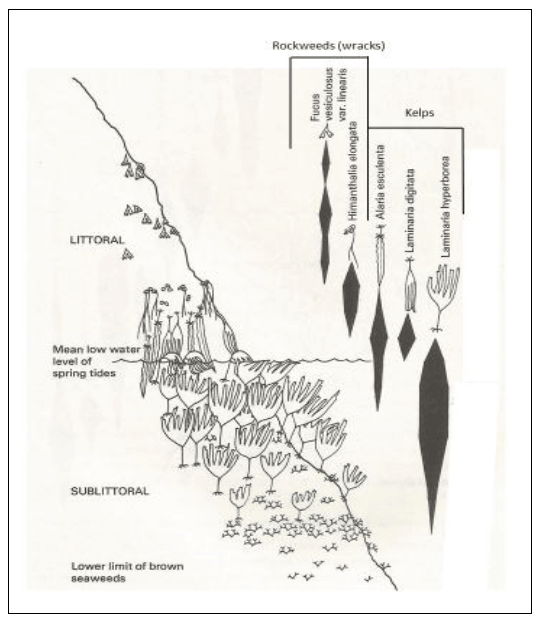
3.6.1. The black kites on Figure 5 indicate the vertical range of occurrence of each species; the width of the kite indicates approximate abundance at any height or depth. Again, it is not possible to show a numerical depth limit in the sublittoral as this depends on water clarity and varies geographically. Most of the intertidal wrack cover is reduced. Fucus vesiculosus is represented by the variety " linearis", which lacks bladders and is of reduced size. Pelvetia canaliculata and F. spiralis are absent. F. serratus has been replaced by the thong weed Himanthalia elongata. A kelp characteristic of strong wave action, Alaria esculenta, occurs around the low water mark and in the shallow sublittoral.
3.7. Pebble and Gravel Shores
Figure 6: Generalised littoral and sublittoral zonation of wracks and kelps on a shore with a substratum of pebbles and gravel (adapted from Hiscock (1979))
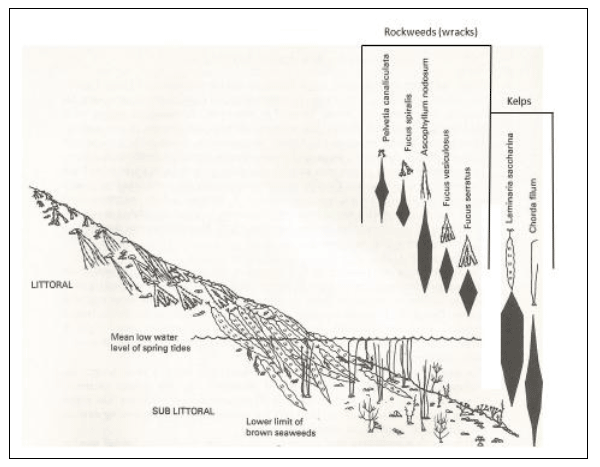
3.7.1. Pebble and gravel shores that can support large seaweeds will be very sheltered and so will have wracks and kelps characteristic of strong shelter. The black kites in Figure 6: Generalised littoral and sublittoral zonation of wracks and kelps on a shore with a substratum of pebbles and gravel (adapted from Hiscock (1979))indicate the vertical range of occurrence of each species with very approximate abundance at any height or depth indicated by the width of the kite. The kelp Laminaria saccharina (now known as Saccharina latissima), occurs on many types of shore, but in this situation it can be dominant around the low water mark and in the shallow sublittoral. The larger Laminaria spp. and Alaria esculenta of solid bedrock shores do not occur here. Chorda filum, the bootlace weed, is a narrow but long string-like kelp restricted to this situation.
3.8. Stratification in Response to Exposure
3.8.1. Figure 7 illustrates two features:
- increased depth penetration of kelps, going from less clear inshore waters to very clear open oceanic waters, and
- change in the dominant, forest-forming kelp species, going from extreme shelter at the head of sealochs through slightly greater wave exposure in the outer parts of sealochs to more wave exposed coastal sites, and finally extremely wave-exposed open oceanic sites.
Figure 7: Depth transition of kelps from sheltered to exposed shores (adapted from Scott (1993).

3.8.2. Below the low water mark, increasing depth results in a very rapid decrease in light intensity so that sublittoral (subtidal) species are restricted to a depth range near the surface, known as the photic zone, where light is sufficient for growth. Within the photic zone species may also be zoned based on their light requirements or their tolerance to damaging wave action around the low water mark.
3.8.3. The effects of wave action occur in both the littoral and sublittoral zones of rocky shores: in general, species can be recognised as characteristic of shelter or characteristic of wave exposure [8] . The two dominant groups of large seaweeds on the shore, wracks and kelps, generally have different habitat preferences. The wracks are almost entirely intertidal, while the kelps dominate the subtidal, forming the kelp forest, but also extend into the lowest intertidal just above the low water mark.
3.9. Seagrasses
3.9.1. In Scotland seagrasses grow in sheltered waters such as inlets, bays, estuaries and saltwater lagoons; in more exposed areas beds tend to be smaller and patchier (Davison & Hughes, 1998). Common eelgrass ( Zostera marina) is the only species that occurs below low water mark, forming dense underwater lawns. The dwarf eelgrass (Z. noltii) grows on sheltered seashores in the intertidal zone and never below low water mark (Davison, 1998 cited in Wilkinson & Wood, 2003). Ruppia maritima (beaked tasselweed) grows in sheltered coastal brackish waters and inland saltwater habitats (lagoons) on soft sediments.
3.10. Long Term Variability
3.10.1. There is considerable diversity in form and life-style amongst seaweeds (Wilkinson, 2001 and 2002). The wracks and kelps are physically large organisms which often dominate particular zones on the shores where they occur. Often these dominant species appear to be stable features of the shore. Ecologists may call them climax species or late successional species because they can be the culmination of a process in which the seaweeds that colonise a bare area of shore go through a progression of different species starting from smaller, simpler ones. The early colonising species are often called opportunist species, and these include Ulva spp. (green seaweeds) and some Porphyra spp. (red seaweeds). Opportunists are generally smaller, have simple form, short life-span, fast growth rate, a relatively wide tolerance to environmental conditions, and are reproductive for most or all of the year so that they can rapidly and opportunistically colonise spaces that occur in habitats. In contrast, late successional or climax species are generally complex in form, may be larger, may have a life-span running into years, with specific reproductive seasons. Although they may be tough they are likely to be well-adapted to a specific set of conditions where they form the climax communities (and therefore may be vulnerable to change in these conditions).
3.10.2. Opportunists are normal members of all communities. A frequent mistake by those concerned with shore monitoring is to interpret their presence as indicating "bad conditions". However, there can be an exceptional abundance of them when there is physical disturbance or considerable nutrient enrichment. In some naturally disturbed habitats, e.g. shores abraded by coarse sand in strong wave action, they may be naturally abundant.
3.10.3. Apparently stable climax communities may change in response to changes in environmental conditions. An example is the replacement of Laminaria communities in Nova Scotia by sea urchins after excessive kelp removal by harvesting (see Section 6.2 ). In Scotland, very abundant and dense seaweed climax communities at Joppa in the Firth of Forth have been replaced by a stable mussel-barnacle community, owing to effects of Edinburgh's sewage discharge (Wilkinson, 2002; Wilkinson et al., 1987).
3.10.4. The growth of seaweeds and seagrasses, their distribution, and ultimately their effectiveness in providing ecological functions and ecosystem services is a result of several climatic and environmental factors which can vary both spatially and temporally. Alterations to temperature, pH and sea levels along with several other factors may result in community shifts which have the potential to affect the ecological functions and ecosystem services currently provided by seaweeds (Jackson et al., 2012).
3.10.5. Rapid warming could impact kelp forests in Scotland, although this is likely to take a long time as L. hyperborea is in the centre of its north-south distribution in Scotland (Brodie et al., 2014). Ocean acidification is likely to result in the loss of maerl habitat (Brodie et al., 2014). Conversely, seagrasses are predicted to proliferate if they are adequately protected from other anthropogenic pressures (Brodie et al., 2014). However, it is possible that increased sea temperature could be a threat to Zostera beds as it will result in an increase in respiration and decrease in photosynthesis (Wilkinson & Wood, 2003).
3.10.6. Combined impacts of seawater warming, ocean acidification, and increased storminess may replace structurally diverse seaweed canopies, with associated calcified and non-calcified flora, with simple habitats dominated by non-calcified, turf-forming seaweeds. In addition, invasive species may dominate in niches liberated by loss of native species (Brodie et al., 2014).
3.11. Uses of Seaweed and Seagrass
3.11.1. Human beings have used seaweed for a wide range of purposes for centuries. Today seaweed continues to be used in a variety of products. The main interest is in:
- horticultural and agricultural applications, e.g. organic fertilisers and animal feed;
- alginates, used in foods, textiles and pharmaceuticals, including as a gelling and thickening agent,
- cosmetics; and
- food products that are marketed as providing health and medical benefits. It is also a human food in its own right.
3.11.2. Seaweed also plays a beneficial role in integrated multi-trophic aquaculture systems, where the by-products from one species are recycled to become inputs for another.
3.11.3. The renewable energy industry is interested in using seaweed in biofuel production. Initial indications are, that in early stages of development, seaweed for biofuel may be a mix of cultivated and wild harvested seaweed.
3.11.4. Seagrass has been used in the past, for example, as a material to thatch roofs, to stuff mattresses and for bandages (Reynolds, no date). Its high nutrient content has also resulted in its being harvested for agricultural uses; however, this has mainly been focused overseas and activity levels have reduced in recent years, partly in response to bans on harvesting in some countries ( CCEES & ABPmer, 2010). The main use of seagrass today appears to be as a craft material (d'Avack et al, 2014), for the manufacture of furniture.
3.12. Current and Future Harvesting Activity
3.12.1. Scotland has a small-scale wild seaweed industry, harvesting a range of brown, red and green seaweeds. The two main types harvested are Ascophyllum nodosum (egg wrack/ knotted wrack) and kelp, usually Laminaria hyperborea, and these comprise the largest volumes harvested. However, other species are also harvested, in smaller volumes, including (but not limited to) saw wrack ( Fucus serratus), carragheens ( i.e. Mastocarpus stellatus and Chondrus crispus), the channel wrack ( Pelvetia canaliculata), dulse ( Palmaria palmata), pepper dulse ( Osmundea spp.) and laver ( Porphyra spp.) (Angus, 2012). Current seaweed harvesting activity mainly takes place in Orkney, the Western Isles, Fife, Ardnamurchan, Loch Sunart, Bute, and Caithness ( Figure 8). Small-scale harvesting took place in Shetland until relatively recently (circa 2010).
3.12.2. Beach-cast seaweed is 'gathered' from the shore in many of Scotland's island communities, for use as a soil conditioner or fertiliser. In the Western Isles, for example, beach-cast Laminaria spp. (and other species mixed with it) are traditionally gathered to spread on machair land (Angus, 2009), which is also important for the biodiversity of the machair (Comhairle Nan Eilean Siar, 2013). Little information is available about the extent or volumes of such gathering.
Figure 8: Location of current commercial harvesting activities in Scotland
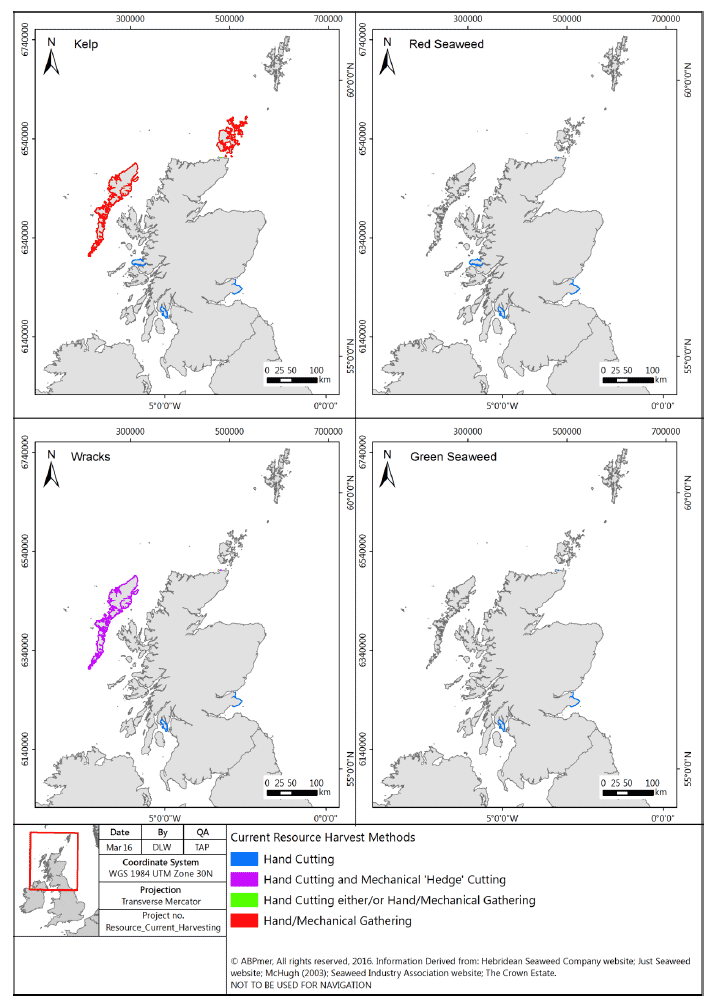
3.13.1. Commercial extraction of maerl does not currently take place in Scotland [9] ( SNH, 2015b). However, the resource is harvested elsewhere in Europe using dredges and grabs (Grall & Hall-Spencer, 2003; Blunden et al., 1975), e.g. in Ireland and Iceland (Celtic Sea Minerals, no date). In England commercial-scale extraction of maerl took place in the River Fal between 1975 and 1991, as much as 30,000 tonnes annually ( UK Marine Special Areas of Conservation webpage [10] ).
3.13.2. No evidence of current seagrass harvesting in Scottish waters has been found [11] .
3.13.3. Table 4 identifies the main seaweed and seagrass species that are either harvested at present or could be harvested in the future. Illustrations of some of these are provided in Figure 1. Further information on these target seaweed and seagrass species is included in Appendix C (Table C1 ), including their general distribution on the shore, growth cycles, and. the nature of the resource ( i.e. living and/or beach-cast).
Table 4: Target seaweed and seagrass species for harvesting
| Seaweeds: |
|
|---|---|
| Brown: wracks |
|
| Ascophyllum nodosum |
F. vesiculosus |
| Fucus serratus |
Himanthalia elongata |
| F. spiralis |
Pelvetia canaliculata |
| Brown: kelps |
|
| Alaria esculenta |
L. digitata |
| Laminaria hyperborea |
Saccharina latissima |
| Green |
|
| Ulva intestinalis |
U. lactuca |
| Red |
|
| Chondrus crispus |
Palmaria palmata |
| Mastocarpus stellatus |
Porphyra umbilicalis |
| Osmundea pinnatifida |
P. purpurea |
| Maerl: |
|
| Lithothamnion glaciale |
Phymatolithon calcareum |
| Seagrasses: |
|
| Ruppia spp. |
Z.noltii |
| Zostera marina |
|
3.13.4. In Scotland, hand cutting has been the most common method of harvesting in the wild (Burrows et al., 2010; Scottish Executive, 2001). Mechanical harvesting has also been used in the past where the seaweed and harvest area were amenable to such methods (Wilkinson, 1995).
3.13.5. The range of methods that are currently used to commercially harvest wild seaweeds, and that could potentially be used to harvest seagrasses, can be classified into five broad groups ( Table 5). These cover methods used in Scotland and in other countries.
Table 5: Classification of commercial wild harvesting methods
| Method |
Description |
|---|---|
| Hand cutting or picking |
This method involves harvesting living species by hand at low tide using tools such as serrated sickles or scythes. |
| Trawling/Sledging/Dredging |
In the case of kelps, this involves a device which tears living plants larger than a certain size from the substrate and leaves smaller plants for re-growth ( i.e. generally only mature plants are harvested). Existing devices include the Norwegian kelp dredge designed to harvest Laminaria hyperborea and the Scoubidou which is designed to harvest L. digitata. These devices operate in areas of rocky substrate and therefore differ from other forms of dredging ( e.g. scallop dredging) that physically disturb the underlying substrate. There may, however, be some potential for physical disturbance of the substrate by other devices ( e.g. dredgers used in maerl extraction). |
| Mechanical 'hedge' cutting |
Specialised vessels called mechanical seaweed harvesters that work close to the shore and cut the living seaweed as the stalks float above the seabed. These vessels include the Norwegian suction/cutter harvester which is designed to harvest Ascophyllum nodosum. |
| Hand gathering |
This method involves the collection of beach-cast species from the strandline by hand. |
| Mechanical gathering |
This method involves the collection of beach-cast species from the strandline using tractors or JCBs. |
3.13.6. A summary of known seaweed harvesting is provided in Figure 8 and Table 6 including the general location, methods and (where known/appropriate) season of harvesting.
Table 6: Summary of harvesting activities in Scotland
| Species |
Known Harvesting Locations |
Generic Methods of Harvesting |
|---|---|---|
| Brown Seaweeds: Wracks or rockweeds |
||
| Ascophyllum nodosum |
Outer Hebrides (specifically Lewis, Harris, North Uist, South Uist) Caithness (Ham to Scarfskerry) |
Intertidal. Harvesting takes place all year. In Caithness, Ascophyllum sp is cut by hand. In the Outer Hebrides cutting is done manually (sickle) or mechanically (seaweed harvesting boat). Manual seaweed harvesters first encircle the cutting area with a rope or net and cut within this area. Seaweed is cut about 12 inches from the base; the stump that is left will regenerate in 3 to 4 years. When the tide comes back in the seaweed floats to form a large circular bale which is then towed by small boat to a sheltered area for loading onto a lorry. Individual cutters handle their own cutting areas and rotate them to ensure sustainability. A mechanical seaweed harvester may also be used. This vessel works close to the shore and cuts the seaweed as the stalks float above the seabed. The seaweed is then filled into sacks and towed by a small boat to a sheltered area for loading onto a lorry. |
| Pelvetia canaliculata |
Fife; Caithness (Ham to Scarfskerry); Bute |
Intertidal. Harvested by hand. |
| Fucus vesiculosus |
Fife; Caithness (Ham to Scarfskerry); Loch Sunart (Salen to Glenmore Bay); Ardnamurchan; Bute |
Intertidal. Typically hand harvested at low tide with small knives or scissors. Recommendation is to cut at a height of 15 to 25 cm above the holdfast. |
| Fucus serratus |
Fife; Caithness (Ham to Scarfskerry); Bute |
Intertidal. Harvested by hand at low tide. Recommendation is to cut at a height of 15 to 25 cm above the holdfast. |
| Fucus spiralis |
Fife; Caithness (Ham to Scarfskerry); Bute |
Intertidal. Harvested by hand at low tide; fronds above the stipe should only be harvested in mature plants. |
| Himanthalia elongata |
Fife; Caithness (Ham to Scarfskerry) |
Intertidal. Gathered by hand during May and June. The fronds are cut at least 10 cm from the mushroom-like base. |
| Brown Seaweeds: Kelps |
||
| Saccharina latissima |
Fife; Caithness (Ham to Scarfskerry) |
Subtidal. Usually harvested in late spring and summer, from boats or by hand at low spring tides. Blades are cut from existing plants, leaving the stipe and lower blade intact and able to keep growing. Juvenile plants are avoided and no plant is removed in its entirety. |
| Laminaria hyperborea |
Outer Hebrides; Orkney; Caithness (Ham to Scarfskerry) |
Subtidal. In Scotland, L. hyperborea is harvested at present for small scale applications. In other countries, it is harvested by specially designed seaweed trawlers that use a dredge. Multiple boats operating along the Norwegian and Icelandic coasts can carry dozens of tons each. Depending on the dredge design, juvenile plants can be avoided. |
| Laminaria digitata |
Fife; Caithness (Ham to Scarfskerry); Loch Sunart (Salen to Glenmore Bay); Ardnamurchan; Bute |
Inter/subtidal. In Scotland, manual harvesting only is undertaken, using a small boat at low tide, usually by stepping out of the boat to cut the seaweed with a knife. In locations with higher tidal range, it may be possible to harvest without a boat. Juvenile plants are avoided. Mechanical methods may be used in other countries. L. digitata beds in Scotland are narrow and therefore mechanical harvesting is unlikely to be viable. |
| Alaria esculenta |
Fife; Caithness (Ham to Scarfskerry) |
Inter/subtidal. In some areas, harvest is during a narrow window in early summer, after plants have put on reasonable growth but before breaking waves shred the thin leaves. Harvesting is often done by hand and knife at low tide. Juvenile plants are avoided. |
| Green Seaweeds |
||
| Ulva intestinalis |
Caithness (Ham to Scarfskerry); Bute |
Intertidal. Scissors or a small knife can be used to cut the blade from the holdfast. If the holdfast is accidentally pulled off from the substrate, it can be cut from the frond before processing. |
| Ulva lactuca |
Fife; Caithness (Ham to Scarfskerry) |
Intertidal. Ulva lactuca often does not grow in large patches, so harvesting can be a labour intensive effort which only yields small amounts. Scissors or a small knife can be used to cut the blade from the holdfast. |
| Red Seaweeds |
||
| Chondrus crispus |
Fife; Caithness (Ham to Scarfskerry); Loch Sunart (Salen to Glenmore Bay); Ardnamurchan; Bute |
Intertidal. The bushy top half of the frond is pulled off, leaving the base and holdfast behind. |
| Mastocarpus stellatus |
Caithness (Ham to Scarfskerry) |
Intertidal. Harvesting is done by hand cutting or raking, usually in late summer. Care must be taken to keep the holdfast and part of the stipe intact so that plants re-grow for subsequent harvest. |
| Palmaria palmata |
Fife; Loch Sunart (Salen to Glenmore Bay); Ardnamurchan; Bute |
Intertidal. It is often harvested from June through September. It is picked by hand at low water. |
| Osmundea pinnatifida |
Fife; Caithness (Ham to Scarfskerry); Bute |
Intertidal. Harvested by hand with scissors or a blade at low tide. |
| Porphyra umbilicalis |
Fife; Caithness (Ham to Scarfskerry); Bute |
Intertidal. Scissor/ small knife used to carefully cut the blade from the holdfast. If the holdfast is accidentally pulled off from the substrate, the holdfast is cut from the frond before processing. |
Sources: Hebridean Seaweed Company website; Just Seaweed website; McHugh (2003); Seaweed Industry Association website; The Crown Estate.
3.13.7. Information on potential future harvesting activity that may be undertaken, in addition to current activity, has been provided by industry. Only two harvesters were able to respond to queries within the timescale of this SEA and therefore this information is not comprehensive. This is shown in Table 7 and Figure 9.
3.13.8. The current and potential distribution of each of the seaweed and seagrass groups shown in Figures 2 and 3, together with the known existing wild harvesting locations shown in Figure 8 provides an indication of the future locations that are likely to be exploited.
Table 7: Summary of potential future harvesting activities in Scotland
| Targeted Species |
Timing* |
Proposed Locations |
Proposed Methods of Harvesting |
|---|---|---|---|
| Himanthalia elongata |
Feb to Jul |
Islands of the southern Firth of Lorn in Argyll (Garvellachs, Scarba, Luing, Easdale, Seil, Insh Lunga, Fladda, Eilean dubh mor, Eilean dubh beag, Mull (near Loch Buie), north shore of Jura) |
Light harvesting working around the coast throughout the year. Harvesting of each species would be annual as each species grows rapidly each year. Harvesting method would involve removing 2/3 of the blade/thallus trying to leave the holdfast and meristem. Where plants are removed accidentally then every other plant is either cut or removed in a patch. All harvesting would be by hand though access to shoreline will be by boat. |
| Saccharina latissima |
|||
| Laminaria digitata |
Jan to Jul |
||
| Alaria esculenta |
(Feb) May to Aug |
||
| Ulva spp. |
(All year round) mainly Apr to Sep |
||
| Chondrus crispus |
Feb to Aug |
||
| Mastocarpus stellatus |
Jan to Aug |
||
| Palmaria palmata |
May to Oct |
||
| Osmundea pinnatifida |
Oct to Apr |
||
| Porphyra sp. |
Apr to Oct |
||
| Laminaria hyperborea |
All year round |
Multiple locations in the Inner Hebrides |
Harvest mature whole plants using mechanical equipment (a comb-like trawl) similar to that used in Norway and Iceland over the last 50 and 30 years respectively, but with a different harvesting regime (namely strips rather than clear felling). |
* Macroalgae communities have different composition at different times of year and therefore the timings could change as the demand changes.
Figure 9: Location of potential additional future commercial harvesting activities in Scotland

3.14. Current Regulation of Wild Harvesting
Marine Licensing
3.14.1. The marine licensing regime - provided under section 21(1) (item 6) of the Marine (Scotland) Act 2010 - may regulate the removal of seaweed in those cases where a vehicle, vessel, aircraft, marine structure or floating container is used to remove the seaweed from the seabed.
3.14.2. It is our assessment that a "one size fits all" approach is not appropriate in regulating the removal of seaweed and so an appropriate and proportionate approach to licensing, dependent upon the circumstances and scale of the proposed removals, will be applied.
3.14.3. Any application for a marine licence must be considered against the need to protect the environment, human health and legitimate use of the sea. Therefore any applicant must provide assessment of the effects of their proposed activity in support of their application. This may involve the collection of 'baseline' data and studies to assess the effects.
3.14.4. After an assessment has been completed it may be appropriate for an ' EIA-type' process, of Screening, Scoping and Environmental Statement stages to be applied. This will allow for the best targeted Environmental Assessment to be undertaken, reducing both likelihood of unnecessary assessments being conducted by the applicant and the risk of future challenge to licensing decisions. Small scale projects would be 'screened out' of such requirements, if appropriate, following consultation. They would still require a lease from The Crown Estate.
3.14.5. The harvest of seaweed under other circumstances does not require a marine licence, however landowner permission may still be required.
3.14.6. General guidance on Marine Licensing can be found online at: http://www.gov.scot/Topics/marine/Licensing
3.14.7. Further guidance on the information required to support an application for a marine licence will be issued by Marine Scotland on completion of the consultation on this Environmental Report.
Landowner Consent
3.14.8. Operations involving the harvesting of living or beach-cast seaweed in the wild, with some exceptions, require the permission of the relevant landowner. These arrangements can range from verbal agreements to formal contracts and specified periods of 'tenure'. Restrictions also apply in some conservation sites, such as Sites of Special Scientific Interest ( SSSIs), and a Habitats Regulations Appraisal ( HRA) would need to be undertaken for any harvesting activities that have the potential to affect designated or proposed European/Ramsar sites and associated features.
3.14.9. The traditional gathering of beach-cast seaweed by crofters does not require landowner permission. The Crofters (Scotland) Act 1993 (as amended) gives crofters access to reasonable use of seaweed under Common Grazings regulations and these rights are attached to particular tenancies.
3.14.10. In cases where The Crown Estate is the landowner, a lease for wild harvesting operations will be issued to operators who collect seaweed for commercial reward. Collection or foraging of seaweed in small quantities for personal use is considered to be akin to "blackberrying" and does not require a lease. The Crown Estate recommend that anyone doing so takes account of environmental sensitivity in collecting anything from the wild.
3.14.11. The Crown Estate applies a proportionate approach to the leasing of wild harvesting activities ( Figure 10). The information that is required from the applicant depends on the proposed scale of the proposed harvesting activity, and can include the following:
- A stock biomass assessment to predict sustainably available annual volumes for each species proposed to be harvested (as an acceptable percentage of standing stock);
- A sustainable harvesting strategy setting out harvesting methods, the proportion of individual plants or plant populations to be harvested, the frequency of removal, wildlife and habitat disturbance considerations, rotational fallowing etc.; and
- A monitoring strategy that sets out the data and records to be collected and maintained to inform the sustainability of the activity undertaken and support the harvesting strategy.
3.14.12. The Crown Estate will grant and levy a fee for the rights to harvest on the condition that SNH can confirm, based on the information supplied by the developer, that they are satisfied that the proposed harvesting activity is sustainable. A lease tends to be for a three year period at the end of which a report must be submitted to inform a review of the sustainability of the harvesting practice, approval of which will allow the lease to be renewed.
3.14.13. Although the lease issued by The Crown Estate delineates the boundaries where harvesting is to take place, it does not grant exclusivity to the seaweed resource in these areas.
Figure 10: The Crown Estate's process for wild harvesting activities
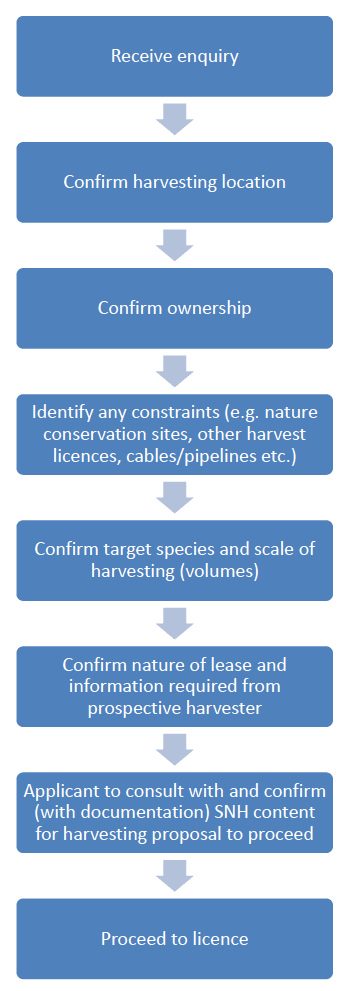
3.15. Current Scottish Policy Framework
3.15.1. The existing legislative and policy context for the licensing of wild harvesting activities is set out in Figure 11. The relevant environmental protection objectives, at the international, European or national level [12] , are summarised below and described in Appendix B .
General Marine
3.15.2. Higher level objectives which direct environmental protection and sustainable development and use are set out in international conventions, European Directives, and UK and Scottish strategy and law, in particular the National Marine Plan. The key messages relate to the need to balance competing interests and objectives in the marine environment with a strong protective framework, whilst facilitating sustainable economic growth.
3.15.3. The Scottish Government's vision is for 'clean, healthy, safe, productive, biologically diverse marine and coastal environments, which are managed to meet the long-term needs of people and nature'.
Biodiversity, Flora and Fauna
3.15.4. These objectives range from broad commitments to protection and enhancement of key species and habitats, to objectives that focus specifically on conserving marine ecosystems. In relation to the marine and coastal environment this includes the protection of migratory species, including birds and fish stocks, protection of marine and coastal habitats, and management of non-native invasive species. Marine mammals, including cetaceans and seals, are also highlighted as requiring specific protection from a range of marine activities. There is strong emphasis on an ecosystems approach to managing and restoring marine and coastal environments. This includes objectives to ensure the proper consideration of ecosystem services in all relevant sectors of policy and decision-making and to halt their loss. Building resilience to climate change is also a cross-cutting theme.
Climatic Factors
3.15.5. These objectives set targets for greenhouse gas ( GHG) emissions at the international and national levels. There are also objectives to increase ecosystem resilience and adaptation to climate change as well as to recognise the importance of ecosystem services in this regard. The policy framework for this topic also explores the actions required to understand the necessary adaptation responses within the marine environment.
Cultural Heritage
3.15.6. These objectives include commitments to protecting the historic environment whilst increasing understanding and awareness of its value. Key objectives relate to coastal and offshore designated and undesignated buildings, archaeology and wrecks.
Figure 11: Legislation and Policy Context for Wild Seaweed Harvesting
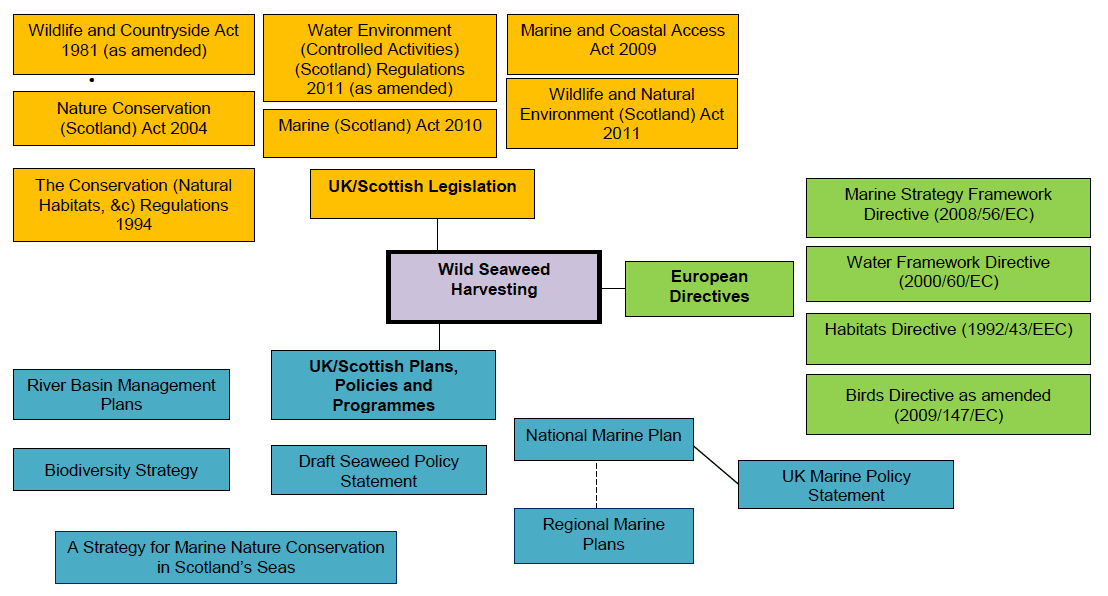
3.16. Ecosystem Services
3.16.1. Ecosystem services are the outputs of ecosystems from which people and society derive benefits. The Millenium Ecosystem Assessment recognised four types of services: provisioning; regulating; supporting; and cultural ( MEA, 2005). Supporting and regulating services also assist in maintaining the biophysical environment that underpins all services. The UK National Ecosystem Assessment ( NEA) Conceptual Framework (2011) identifies intermediate and final ecosystem services and goods/benefits ( Figure 12).
3.16.2. Seaweeds and seagrasses have a role in supporting food webs which contribute to fish and shellfish productivity, as well as several ecosystem services that have both direct and indirect benefits for human beings ( CCEES & ABPmer, 2010), in particular:
- Fish and shellfish - supporting local fish populations and in turn commercial fisheries through their high biodiversity and use as spawning and nursery grounds;
- Algae and seaweed -direct benefit to human beings (see Section 2.4);
- Natural hazard protection - provision of a natural coastal defence through wave dampening and preventing or alleviating coastal erosion;
- Climate regulation - provision in regulating the climate through their important role in the carbon cycle in terms of capturing, storing and exporting carbon; and
- Clean water and sediments - provision in improving the quality of water through their role in nutrient cycling.
3.16.3. The ecosystem services that have been scoped into this SEA are described in more detail in the relevant sections of this Environmental Report.
Figure 12: The classification of ecosystem services and goods and benefits
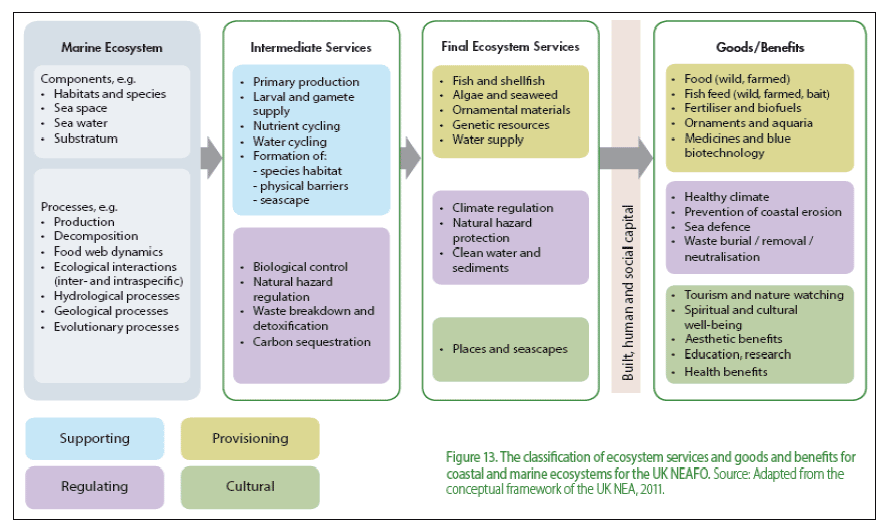
Contact
There is a problem
Thanks for your feedback